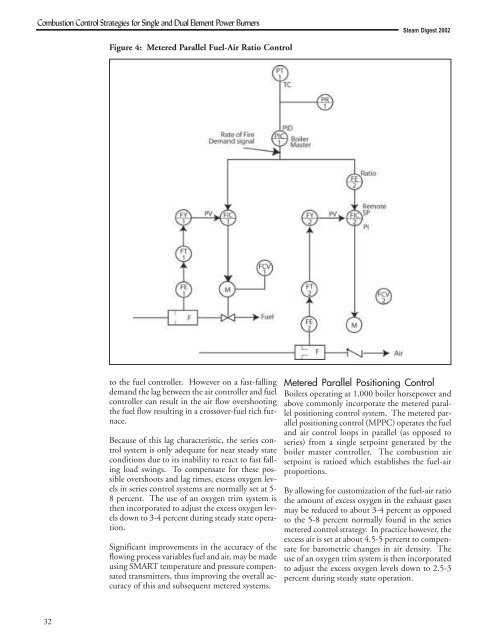Steam Digest 2002 - CiteSeerX
Steam Digest 2002 - CiteSeerX
Steam Digest 2002 - CiteSeerX
You also want an ePaper? Increase the reach of your titles
YUMPU automatically turns print PDFs into web optimized ePapers that Google loves.
Combustion Control Strategies for Single and Dual Element Power Burners<br />
32<br />
Figure 4: Metered Parallel Fuel-Air Ratio Control<br />
to the fuel controller. However on a fast-falling<br />
demand the lag between the air controller and fuel<br />
controller can result in the air flow overshooting<br />
the fuel flow resulting in a crossover-fuel rich furnace.<br />
Because of this lag characteristic, the series control<br />
system is only adequate for near steady state<br />
conditions due to its inability to react to fast falling<br />
load swings. To compensate for these possible<br />
overshoots and lag times, excess oxygen levels<br />
in series control systems are normally set at 5-<br />
8 percent. The use of an oxygen trim system is<br />
then incorporated to adjust the excess oxygen levels<br />
down to 3-4 percent during steady state operation.<br />
Significant improvements in the accuracy of the<br />
flowing process variables fuel and air, may be made<br />
using SMART temperature and pressure compensated<br />
transmitters, thus improving the overall accuracy<br />
of this and subsequent metered systems.<br />
<strong>Steam</strong> <strong>Digest</strong> <strong>2002</strong><br />
Metered Parallel Positioning Control<br />
Boilers operating at 1,000 boiler horsepower and<br />
above commonly incorporate the metered parallel<br />
positioning control system. The metered parallel<br />
positioning control (MPPC) operates the fuel<br />
and air control loops in parallel (as opposed to<br />
series) from a single setpoint generated by the<br />
boiler master controller. The combustion air<br />
setpoint is ratioed which establishes the fuel-air<br />
proportions.<br />
By allowing for customization of the fuel-air ratio<br />
the amount of excess oxygen in the exhaust gases<br />
may be reduced to about 3-4 percent as opposed<br />
to the 5-8 percent normally found in the series<br />
metered control strategy. In practice however, the<br />
excess air is set at about 4.5-5 percent to compensate<br />
for barometric changes in air density. The<br />
use of an oxygen trim system is then incorporated<br />
to adjust the excess oxygen levels down to 2.5-3<br />
percent during steady state operation.
















